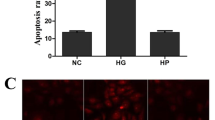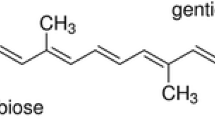Abstract
Background
The retinal vascular endothelial cells can be damaged by oxidative stress even in the early stage of diabetic retinopathy (DR). This study aimed to investigate the protective effect of curcumin on the rat retinal vascular endothelial cells (RRVECs) in high glucose circumstance.
Objective
The cultured RRVECs were identified and characterized by both of vWF and CD31 immunofluorescence expression. The activation of ROS/NF-κB signal pathway was examined by electrophoretic Mobility Shift Assay (EMSA), immunohistochemistry and Western blot; the apoptosis of RRVECs was tested by flow cytometry.
Results
We found that curcumin reduced the reactive oxygen species (ROS) and relieved the apoptosis in RRVECs exposed to the high glucose by flow cytometry. It was revealed that the increased activity of NF-κB and phosphorylated NF-κB in RRVECs induced by high glucose concentration was significantly suppressed by curcumin.
Conclusion
We concluded that curcumin could suppress the oxidative stress via regulation of NF-κB signal to protect the RRVECs in DR.




Similar content being viewed by others
References
Aggarwal BB, Deb L, Prasad S (2014) Curcumin differs from tetrahydrocurcumin for molecular targets, signaling pathways and cellular responses. Molecules 20:185–205
Ahmed S, Mundhe N, Borgohain MP, Chowdhury L, Kwatra M, Bolshette N, Ahmed A, Lahkar M (2016) Diosmin modulates the NF-kB signal transduction pathways and downregulation of various oxidative stress markers in alloxan-induced diabetic nephropathy. Inflammation 39:1783–1797
Ahsan H (2015) Diabetic retinopathy–biomolecules and multiple pathophysiology. Diabetes Metab Syndr 9:51–54
Alder VA, Su EN, Yu DY, Cringle SJ, Yu PK (1997) Diabetic retinopathy: early functional changes. Clin Exp Pharmacol Physiol 24:785–788
Bhat OM, Kumar PU, Giridharan NV, Kaul D, Kumar MJM, Dhawan V (2015) Interleukin-18-induced atherosclerosis involves CD36 and NF-κB crosstalk in Apo E−/− mice. J Cardiol 66:28–35
Caradonna F, Cruciata I, Schifano I, La Rosa C, Naselli F, Chiarelli R, Perrone A, Gentile C (2018) Methylation of cytokines gene promoters in IL-1β-treated human intestinal epithelial cells. Inflamm Res 67:1–11
Chuengsamarn S, Rattanamongkolgul S, Luechapudiporn R, Phisalaphong C, Jirawatnotai S (2012) Curcumin extract for prevention of Type 2 diabetes. Diabetes Care 35:2121–2127
Cunhavaz J, Leite E, Sousa J, De Abreu JRF (1993) Blood-retinal barrier permeability and its relation to progression of retinopathy in patients with type 2 diabetes. A four-year follow-up study. Graefes Arch Clin Exp Ophthalmol 231:141–145
De Abreu JRF, Silva R, Cunhavaz J (1994) The blood-retinal barrier in diabetes during puberty. Arch Ophthalmol 112:1334–1338
Fan Y, Qiao Y, Huang J, Tang M (2016) Protective effects of panax notoginseng saponins against high glucose-induced oxidative injury in rat retinal capillary endothelial cells. Evid-Based Complement Altern Med 2016:5326382–5326382
Ghosh S, Banerjee S, Sil PC (2015) The beneficial role of curcumin on inflammation, diabetes and neurodegenerative disease: a recent update. Food Chem Toxicol 83:111–124
Greenwood J (1992) Characterization of a rat retinal endothelial cell culture and the expression of P-glycoprotein in brain and retinal endothelium in vitro. J Neuroimmunol 39:123–132
Gupta SK, Kumar B, Nag TC, Agrawal SS, Agrawal R, Agrawal P, Saxena R, Srivastava S (2011) Curcumin prevents experimental diabetic retinopathy in rats through its hypoglycemic, antioxidant, and anti-inflammatory mechanisms. J Ocul Pharmacol Ther 27:123–130
Hassan HA, Elgharib NE (2015) Obesity and clinical riskiness relationship: therapeutic management by dietary antioxidant supplementation—a review. Appl Biochem Biotechnol 176:647–669
Heger M, Van Golen RF, Broekgaarden M, Michel MC (2013) The molecular basis for the pharmacokinetics and pharmacodynamics of curcumin and its metabolites in relation to cancer. Pharmacol Rev 66:222–307
Hiscott J, Marois J, Garoufalis J, D’Addario M, Roulston A, Kwan I, Pepin N, Lacoste J, Nguyen H, Bensi G (1993) Characterization of a functional NF-kappa B site in the human interleukin 1 beta promoter: evidence for a positive autoregulatory loop. Mol Cell Biol 13:6231–6240
Juvekar A, Ramaswami S, Manna S, Chang T, Zubair A, Vancurova I (2012) Electrophoretic mobility shift assay analysis of NFκB transcriptional regulation by nuclear IκBα. Methods Mol Biol 809:49–62
Kady N, Yan Y, Salazar T, Wang Q, Chakravarthy H, Huang C, Beli E, Navitskaya S, Grant MB, Busik JV (2017) Increase in acid sphingomyelinase level in human retinal endothelial cells and CD34+ circulating angiogenic cells isolated from diabetic individuals is associated with dysfunctional retinal vasculature and vascular repair process in diabetes. J Clin Lipidol 11:694–703
Kitaoka Y, Isenoumi K, Kumai T, Kobayashi S, Ueno S (2003) Nitric oxide inhibits NMDA-induced activation of NF-kB in rat retina. Invest Ophthalmol vis Sci 44:4577–4577
Kowluru RA, Mishra M, Kumar B (2016) Diabetic retinopathy and transcriptional regulation of a small molecular weight G-Protein, Rac1. Exp Eye Res 147:72–77
Mohammadi A, Yaghoobi MM, Gholamhoseyniannajar A, Kalantarikhandani B, Sharifi H, Saravani M (2016) HSP90 inhibitor enhances anti-proliferative and apoptotic effects of celecoxib on HT-29 colorectal cancer cells via increasing BAX/BCL-2 ratio. Cell Mol Biol (noisy-Le-Grand) 62:62–67
Prasad S, Gupta SC, Tyagi AK, Aggarwal BB (2014) Curcumin, a component of golden spice: from bedside to bench and back. Biotechnol Adv 32:1053–1064
Rojas M, Lemtalsi T, Toque HA, Xu Z, Fulton D, Caldwell RW, Caldwell RB (2017) NOX2-induced activation of arginase and diabetes-induced retinal endothelial cell senescence. Antioxidants 6:43
Roy S, Kern TS, Song B, Stuebe C (2017) Mechanistic insights into pathological changes in the diabetic retina: implications for targeting diabetic retinopathy. Am J Pathol 187:9–19
Scholz CC, Cavadas MAS, Tambuwala MM, Hams E, Rodriguez J, Von Kriegsheim A, Cotter P, Bruning U, Fallon PG, Cheong A (2013) Regulation of IL-1β–induced NF-κB by hydroxylases links key hypoxic and inflammatory signaling pathways. Proc Natl Acad Sci USA 110:18490–18495
Sone H, Deo BK, Kumagai AK (2000) Enhancement of glucose transport by vascular endothelial growth factor in retinal endothelial cells. Invest Ophthalmol vis Sci 41:1876–1884
Stitt AW, Curtis TM, Chen M, Medina RJ, McKay GJ, Jenkins A, Gardiner TA, Lyons TJ, Hammes H-P, Simó R, Lois N (2016) The progress in understanding and treatment of diabetic retinopathy. Prog Retin Eye Res 51:156–186
Tonade D, Liu H, Palczewski K, Kern TS (2017) Photoreceptor cells produce inflammatory products that contribute to retinal vascular permeability in a mouse model of diabetes. Diabetologia 60:2111–2120
Vasquez DH, Diaz MF, Sanhueza C, Castiglione E, Gonzalez I, Valenzuela R, Owen GI, Leyton L (2014) Curcumin inhibits both hypoxia-induced VEGF up regulation in retinal pigment epithelium cells and angiogenesis of choroidal vascular cells. Invest Ophthalmol vis Sci 55:603–603
Wang FH, Liang YB, Zhang F, Wang JJ, Wei WB, Tao QS, Sun LP, Friedman DS, Wang N, Wong TY (2009) Prevalence of diabetic retinopathy in rural China: the handan eye study. Ophthalmology 116:461–467
Wang Q, Liu S, Tang Y, Liu Q, Yao Y (2014) MPT64 protein from Mycobacterium tuberculosis inhibits apoptosis of macrophages through NF-kB-miRNA21-Bcl-2 pathway. PLoS ONE 9:e100949
Wang Y, Wang R, Wang Y, Peng R, Wu Y, Yuan Y (2015) Ginkgo biloba extract mitigates liver fibrosis and apoptosis by regulating p38 MAPK, NF-κB/IκBα, and Bcl-2/Bax signaling. Drug Des Dev Ther 9:6303–6317
Wei C, Li L, Gupta S (2014) NF-κB-mediated miR-30b regulation in cardiomyocytes cell death by targeting Bcl-2. Mol Cell Biochem 387:135–141
Xie XW, Xu L, Wang YX, Jonas JB (2008) Prevalence and associated factors of diabetic retinopathy. The Beijing Eye Study 2006. Graefes Arch Clin Exp Ophthalmol 246:1519–1526
Zhu W, Wu Y, Meng Y, Wang J, Xu M, Tao J, Lu J (2015) Effect of curcumin on aging retinal pigment epithelial cells. Drug Des Dev Ther 9:5337–5344
Acknowledgements
This work was supported by Jiangsu Province Traditional Chinese Medicine Science and Technology Development Program Project(YB2020060); the Second affiliated hospital of Soochow University Research fund project (SDFEYBS1903 and SDFEYBS1914); National Natural Science Foundation of China (No. 81671270); the Second affiliated hospital of Soochow University preponderant clinic discipline group project funding (XKQ2015002).
Author information
Authors and Affiliations
Contributions
In this work, JH, YL and QY conceived the study and designed the experiments. JH, YL, QY,YC and TN performed the experiments. YC and GX contributed to the data collection; JZ, TN, XJ,WZ and YY performed the data analysis and interpreted the results. JH and WL wrote the manuscript; WL contributed to the critical revision of article.
Corresponding author
Ethics declarations
Conflict of interest
Jiang Huang, Quanyong Yi, Yuhong You,Yao Chen, Tongtong Niu, Yi Li, Ji Zhang, Xiaoyan Ji, Guoxu Xu, Weijie Zou,Fangfang Ji and Weifeng Luo declare that they have no conflict of interest.
Ethics approval
All animal experiments were conducted following the guidelines of China Council on Animal Care and Use. The study was approved by the Ethical Committee of the Second affiliated Hospital of Soochow University.
Additional information
Publisher's Note
Springer Nature remains neutral with regard to jurisdictional claims in published maps and institutional affiliations.
Rights and permissions
About this article
Cite this article
Huang, J., Yi, Q., You, Y. et al. Curcumin suppresses oxidative stress via regulation of ROS/NF-κB signaling pathway to protect retinal vascular endothelial cell in diabetic retinopathy. Mol. Cell. Toxicol. 17, 367–376 (2021). https://doi.org/10.1007/s13273-021-00144-7
Accepted:
Published:
Issue Date:
DOI: https://doi.org/10.1007/s13273-021-00144-7




